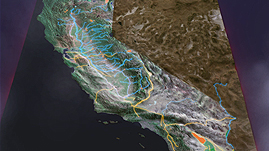Teachers' Domain - Digital Media for the Classroom and Professional Development
User: Preview





California is considered a "dry state." So how is it home to one of the largest populations in North America? In this video, taken from QUEST, learn about California's delicate balance of it's water resources and the historical measures that have made living in California possible for its residents.
Humans are made up on average of 70% water by mass, so it is not surprising that we are extremely dependent on water as a resource. So where does the water that people consume come from? How does it get to us and how does it become potable for humans to consume?
The water cycle, also known as the hydrologic cycle, is the process through which water moves from place to place on the planet. The entire process revolves around the sun, which is constantly heating up the oceans where 97% of all the world's water is stored. The heat of the sun vaporizes salt water in the oceans until it is distilled into pure water. Through convection, the pure water vapor is lifted up into the atmosphere where it cools and condenses into small water particles forming clouds.
After the water is trapped as clouds in the air, the water travels along the various jet streams in the upper atmosphere. As the clouds travel, the water particles collide with each other finally accumulating into larger droplets. Finally, when the drops are heavy enough, they fall as rain or snow all over the world.
If the water falls as snow in high elevations it can be stored as large ice rivers, known as glaciers which, in the springtime when the weather is warmer, melt and seep into nearby streams and rivers and eventually, back out to sea where the cycle continues. Some of the water that falls as precipitation forms streams that do not flow into larger rivers, but instead flow into freshwater lakes. Not all the water flows into these destinations of rivers and lakes. Some of this water seeps into the ground through a process known as infiltration.Here, water either seeps underground as streams and rivers, or stays in the soil as ground moisture, retained within loose rock, clay, sand and silt forming underground springs called aquifers.
 Loading Standards
Loading Standards